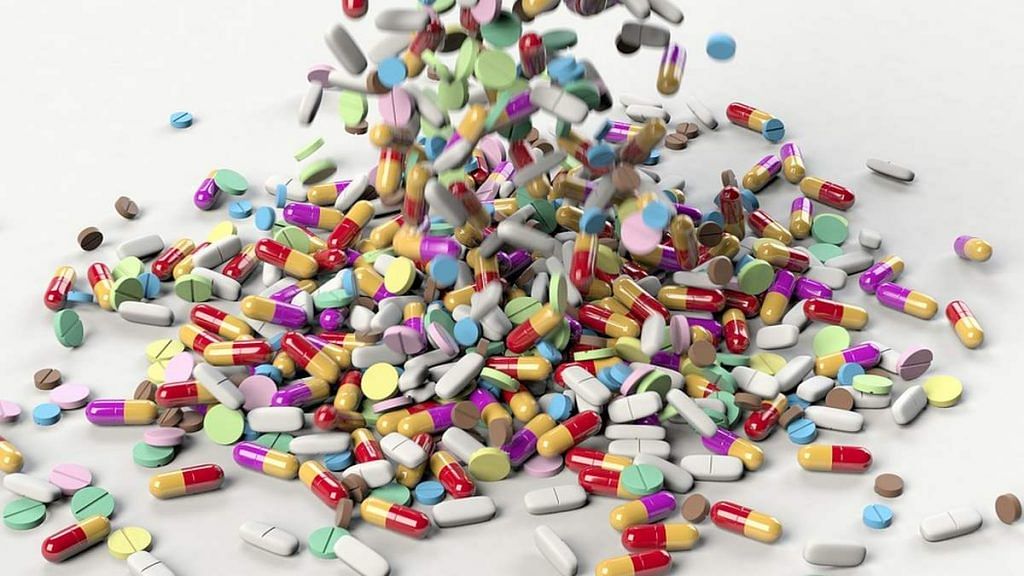The National Pharmaceutical Pricing Authority last week raised the ceiling price of 21 essential drugs by 50 per cent to offset the rise in cost of ingredients imported from China. The present policy, Drug Price Control Order of 2013, has neither been very successful nor it is free of unintended consequences. Instead of existing price control mechanisms, the Indian government needs to find better remedies for sustainable production of drugs.
The price ceiling policy has been in place for more than two decades and India has one of the lowest drug prices in the world. But the out-of-pocket expenditure on healthcare remains high (61 per cent) and many Indians continue to be deprived of access to life-saving drugs. In terms of their relative per capita income, Indian consumers pay more than people in high-income countries. Hence, accessibility and affordability still remain critical challenges in India’s healthcare system.
Also read: Capping profits will wipe out low-cost generic medicines, drugmakers write to PM Modi
The unintended consequences
In India, prices of essential drugs are regulated by the central government under the Essential Commodities Act, 1955. The rationale behind price ceilings is to make drugs cheaper and easily accessible to everyone. This is important because a large section of the Indian population finds it difficult to bear the cost of medications, which forms a significant chunk of out-of-pocket expenditure on healthcare.
The National Pharmaceutical Pricing Authority (NPPA) was set up in 1997 to fix or revise prices of pharmaceutical products, enforce the provisions of DPCO (Drug Price Control Order) and monitor the prices of controlled and decontrolled drugs. Currently, DPCO lists 851 drug formulations whose prices can be capped. This policy is applicable for a specified dosage. The ceiling price is the average price for all brands selling a particular drug with more than 1 per cent of market share. If the price of a drug is below the ceiling price, it can be raised only after a year. This policy is, however, not applicable for patented drugs or fixed-dose combination (FDC) drugs.
The current drug price control policy has had many unintended consequences. For example, many pharmaceutical companies have opted to go out of production because their profit margins decreased. This has led to substandard and spurious drug manufacturers dominating the pharma market. In the absence of strict quality regulations, there has been a trade-off between price and quality; a report by the United States Trade Representative claims that 20 per cent of drugs in India are fake. Decrease in profit margins of quality manufacturers has led to a reduction in spending in research and development. It has deterred future investments in the pharmaceutical sector.
Many manufacturers migrated to non-essential drugs (80 per cent of the drugs in non-essential list) or stopped promoting essential drugs. For instance, an anti-fungal cream called Tolnaftate has not been promoted for several years now. Thus, the sale fell for drugs with capped prices, and rose for drugs that didn’t have a price ceiling. Moreover, there has not been much impact on the prices of many life-saving drugs (for example, HIV, cancer, non-communicable diseases) since they have not been on the list.
Some pharmaceutical companies in India have started promoting different drug categories: non-National List of Essential Medicines (NLEM), FDCs (not on NLEM) and non-standard dosages (for instance, doctors routinely prescribe splitting of medicines). An information asymmetry between the buyer and the seller has created a breeding ground for mis-selling and misinformation (adding or changing of ingredients) in India’s pharma industry.
Also read: Indians pay 70% less than the global median to buy medicines, study finds
Not price ceiling, need for other mechanisms
As prices of costlier drugs decrease, there is a tendency for a poor consumer to opt for a recognisable brand. The company selling drugs at a lower price loses the incentive to sell it at that price. Also, the chances of frivolous patents (as patented drugs are not on the essential list) have increased. The policy has also forced manufacturers to import Active Pharmaceutical Ingredients (API) and bulk drugs from China to reduce their input costs. So, it has damaged India’s indigenous drug manufacturing industries. About two-thirds of APIs are imported from China. Any threat from China has the potential to impact the manufacturing of critical drugs in India.
Also read: To fight China monopoly, Modi govt to speed up approvals for 4 mega bulk drugs parks
Instead of price controls, other mechanisms like promoting competition among manufacturers, strictly regulating the quality of drugs, bulk procurement of generic drugs by public institutions for distribution (Tamil Nadu being a good example), increase in public spending on healthcare, and tackling information asymmetry by promoting transparency will deliver better outcomes for India’s pharmaceutical industry .
The author is a public policy professional and a consultant at the Takshashila Institution. Views are personal.
